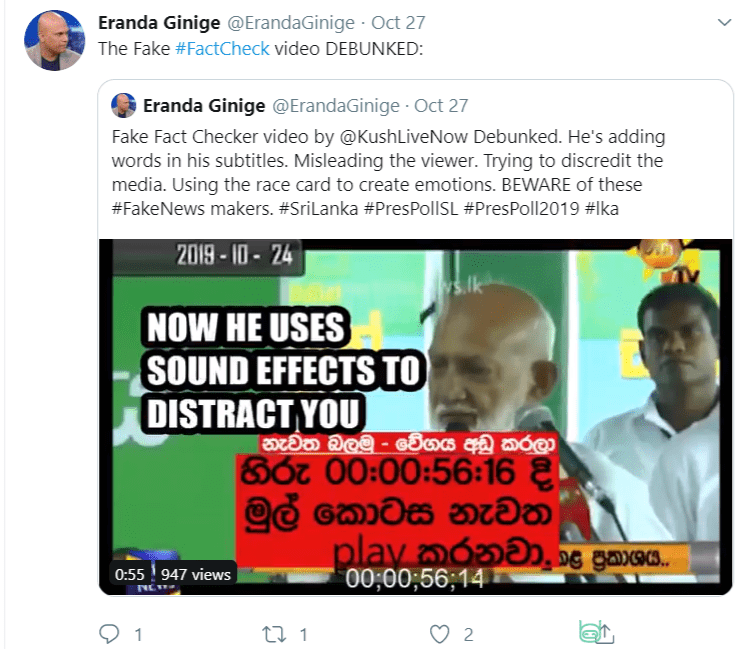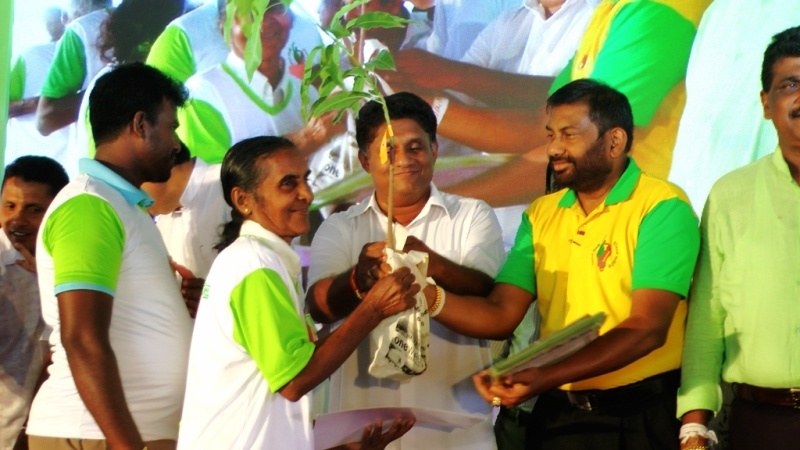By Sandun Arosha Fernando
When Hiru News ran a news on Oct. 24, mistakenly said that former minister A.H.M. Fowzie in public said presidential front runner, Gotabaya Rajapaksa should be murdered, fake account @Ranjanieguruge tweeted it and made it as if the minister had really said the presidential candidate should be murdered in public.
Later it was transpired that the ex-minister had said Rajapaksa should be defeated (paradhdhanna) and not murdered (maranna).
Hiru News, which openly backed Rajapaksa’s campaign in the Nov. 16 presidential poll, later took down its twitter post after news was verified, but @Ranjanieguruge never took it down.
@Ranjanieguruge’s twitter feed is with a close profile picture of Rajapaksa’s close rival Sajith Premadasa where a section of his face be seen and profusely sweating.
The recorded video version of Fowzi’s original speech repeatedly verified showed he only said Gotabaya Rajapaksha should be defeated (paradhdhanna) and not murdered (Mmaranna). The former minister later at a Media briefing condemned the news by the Sinhala news channel.
An official at Hiru TV News Division said they removed the section which stated “former minister A.H.M. Fowzie said that Gotabaya Rajapaksa should be murdered” after it telecast it first in its 6.55 pm in their prime time news bulletin.
“Apart from that I cannot say anything,” the official said, asking not to be named as he was not authorized to talk to Media on their own company matters.
@Ranjanieguruge also posted a tweet saying Rajapaksa’s rival Sajith Premadasa signed an agreement with the Tamil National Alliance (TNA) to grant Eelam, an independent state Tamil Tiger separatists fought for in a 26-year war. Such sentiments were to reduce Premadasa’s winning probability, given that many Sri Lankans are still terrified of the suicide bombs and atrocities when Liberation Tigers of Tamil Eelam (LTTE) waged the war.
@Ranjanieguruge is one of thousands of fake accounts which information without verification and it later transpired that he is an ardent supporter of the Sri Lanka Podujana Peramuna (SLPP) presidential candidate.

The reach of bots
fake account @Ranjanieguruge had the reach of 53,380 tweets within 24 hrs between 5 and 6 November, when it was analysed, according to Union Metrics a leading profile analytics company.
His tweet was reweeted by other fake accounts like @sraddhabuddhi (1346 followers), @Neetwit (2401 followers), @ajasaththa (247 followers), and @NishminiR (2,126 followers).
All these accounts were found to have used to disseminate unproven fake news against Rajapaksa’s rival and defeated presidential candidate Premadasa.
All These fake accounts followed supporter of Rajapaksha camp, Eranda Ginige (@ErandRajapaksha artiste, Iraj Weeraratne (@irajonline) and website MadaPeradiga.com (@medaperagiga).
All these three twitter handles follow current prime minister Mahinda Rajapaksa-led SLPP’s official twitter account @podujanaParty.
@KushLiveNow is a twitter feed under the name of Kushan Liyanarachchi who claims that he is Professor in Big Data Analytics Data Scientist and an Apolitical Fact-Checker. Liyanarachchi has been trolled for his fact checked tweets by many twitter followers of Eranda Ginige
Eranda Ginige endorsed this fake news and commented on his twitter feed saying: “So, now they say he said it, but he didn’t mean it… So much for @KushLiveNow‘s Fake #FactCheck with imaginary subtitles.
You can hate me, insult me and vilify me.But you can never silence me, Sirs and Madams. MP and Minister A H M Fowzie said ”@”.#SriLanka#PresPollSL”Ginige, who has openly backed the current president, Gotabaya Rajapaksa in his twitter before the election, when asked about disseminating the fake news on Fowzi, confidently he said that the former Minister said the word ‘Murder’ (maranna), when he only uttered the word ‘Defeat’ (paradhdhanna).
He said “Fowzie’s words cannot be taken lightly”, given the background of murders of former prime minister S.W.R.D. Bandaranaike (1959), former president Ranasinghe Premadasa (1993), and presidential candidate Gamini Dissanayaka (1994).
“The definition for assassination is murdering an important person for political or religious reason. Fowzie’s reason is to protect the SLFP. It is a clear ‘Political’ reason. So as responsible citizens it is our duty to condemn and expose such dangerous call to action.” Ginige said.
Pro-Rajapaksa artiste Iraj Weerathana (@irajonline) declined to comment despite repeated calls and a text message as to whether he endorsed such fake news.
Confusing the public
Former army commander General Mahesh Senanayaka contested on the National People’s Party ticket. This was t]a political front registered by the former UNP provincial candidate Srinath Perera. Iran retweeted a tweet by pro-Rajapaksha tweep, Dr. Amila Kankanamge (@amilak) which in Sinhala gave a misinterpretation that the former Army Chief was contesting on behalf of the UNP.
Similar to this, social media tools such as Twitter and WhatsApp were heavily used to confuse voters during the election by both main parties. Hundreds of pro-UNP fake accounts confused the public of presidential candidate, Gotabaya Rakapaksha’s renunciation of the United States Citizenship.
Unfortunately, many people who had political affiliation to both main parties also Re-tweeted and disseminated false information deliberately or without their knowledge. Some of the neutral tweeps who tried to verify the false information to let the public know the truth, were mostly trolled or attacked in social media by the party which tried to confuse voters.
Spread
Fake account @ganewattak, a second layer fake account in this particular tweet, has spread the fake information through twitter to many other suspected bots or fake accounts either through responding to other’s queries.
For example, this tweet which was originally posted by fake account @ranjaniguruge is re-tweet by @ganewattak. This tweet ridiculed a UNP campaign song and suggested that UNP was leading for a fake one.
“Netlytic” analyses show that these bots link to many other bots again, as they try to amplify their message.
fake account @ganewattak, a second layer fake account in this particular tweet, has spread the fake information through twitter to many other suspected bots or fake accounts either through responding to others’ queries .
“Netlytic” visualizations show @ganewattak, who created his or her twitter feed on 28 October four days after Fowzie’s fake news was aired on Hiru TV, and stopped tweeting after the election.
Though dissemination of fake news and misinformation through Facebook, Twitter, and WhatsApp were rampant, the then government totally failed to control those fake accounts and counter false information.
Many of these trolls had de-activated their twitter accounts after the Elections. When attempting to contact through twitter messenger, some have deliberately disabled their direct message feature.
Bots like @neetwit, @nnalani1231, and @gayanigunaseke2 did not respond despite our attempts to get their views on spreading fake news.
@apiwenuwen in its reply said they are not considering personal identification as they were tweeting for a cause of saving the country from UNP, whose supporters they believe are backing pro-LTTE TNA.
“We draw a picture of a person after carefully analysing about him even if it is one of our personally known relatives who are backing pro-Tamil Tiger leaders. Therefore, we are friendly only on the “opinions” about this country and not for money.
Fake news disseminators like @ajasaththa , @Denzel31565966 do not exist anymore after the election.
Trolls in Sri Lanka presidential election worked to promote candidates, campaigning against rival candidates, and have been attacking fact-checkers & journalists.
Social Media Expert Prasad Perera said bot is a computer programme that performs automatic repetitive tasks. Siri and Cortana are also bots and they can certainly be misused too.
“There are bots and bot army on twitter. Most Twitter-bots work simply, sending out tweets periodically or responding to instances of specific phrases in user messages. More sophisticated Twitter bots perform various tasks, such as spreading disinformation, data mining and analyzing tweets in real-time too “ he said.
Rohana Hettiarachchi, The Executive Director of People’s Action for Free and Fair Election (PAFFREL) said the posts with misinformation which circulate in social media has significantly influenced the voters”.
[This report was produced under the CIR Investigative Journalism Fellowship Program 2019/2020]




